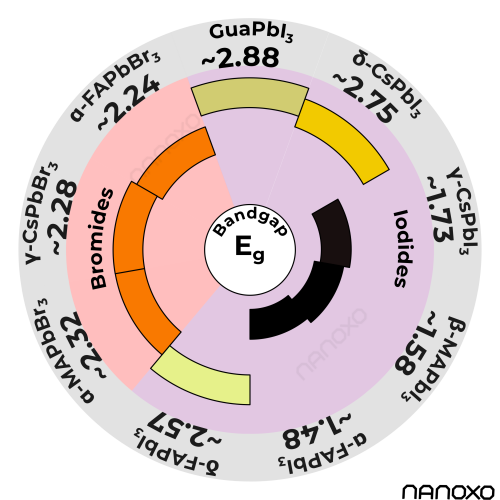Solvent-free solid-state Perovskites
Metal Halide Perovskites - solid-state semiconducting, light-harvesting materials with tunable optoelectronic properties. An inexpensive and promising alternative for traditional silicon solar cells.
| A-site cations | B-site cations | X-site anions | |
| Methylammonium (MA) Formamidinium (FA) Guanidinium (Gua) Cesium | (CH3NH3+) (HC(NH2)2+) (C(NH2)3+) (Cs+) | Lead Pb2+ | Chloride Cl- Bromide Br- Iodide I- |
The ABX3 is a general formula of semiconducting metal halide perovskites, where A represents monovalent organic or inorganic cations, B stands for a metal center, while X denotes a halide anion. With an easily modifiable formula, a vast array of perovskite materials can be combined, such as the hybrid organic-inorganic and all-inorganic ones. Both groups possess unique physicochemical and tunable optoelectronic properties, making them an excellent choice for applications as light-harvesting materials for solar cells, photodetectors, catalysts, and light emitters.
Nanoxo approach
To keep pace with green chemistry conventions and environmental friendliness, Nanoxo, decided to implement a waste-free and solvent-free manufacturing process. To provide top-notch quality materials, we produce perovskites using the selected reagents that meet the highest phase purity demand.
Why dry synthesis?
Over the last decade, extensive worldwide research over metal halide perovskites gained exceptional momentum with the new generation of solution-processed solar cells. Within a decade, the power conversion efficiency of those devices was streamlined, even up to 25%. However, perovskites synthesis and solar cells manufacturing include utilizing hazardous organic solvents.
Therefore, to prevent the enormous contribution of harmful organic solvents in the course of perovskites’ synthesis, we implemented a solid-state manufacturing process. We ensure the repeatability and scalability of the solvent-free synthesis, providing remarkably high phase purity of the products. The reaction of dry powders also eliminates the formation of solvent adducts, arising through their coordination to perovskites, resulting in crystal lattice defects.
Device performance
Solvent-free solid-state synthesis method ensured the remarkable improvement of perovskite solar cells parameters. Devices manufactured with inks made from dry perovskites exhibited reduced I-V hysteretic behavior, increased open-circuit voltage values (VOC), and considerably better thermal stability due to a higher degree of materials' crystallinity. Moreover, the utilization of the solvent-free synthesis method guarantees complete control over reaction stoichiometry, thereby preventing the presence of starting materials.
Tunable optoelectronic properties.
Compositional engineering enables the design of desired products and tuning of their optoelectronic properties. The most important one, considering semiconductors, is the bandgap. Nanoxo provides bromide and iodide hybrid and all-inorganic perovskites with a bandgap range from 1.5 – 2.9 eV.
| Composition | Bandgap [eV] | Color |
| β-MAPbI3 | ~ 1.5 | Black |
| δ-FAPbI3 → α-FAPbI3 | ~ 2.6 (δ) → ~ 1.5 (α) | Yellow to black |
| δ-CsPbI3 → γ-CsPbI3 | ~ 2.7 (δ) → ~ 1.7 (γ) | Yellow to dark brown |
| δ-GuaPbI3 | ~ 2.9 | Pale yellow |
| α-MAPbBr3 | ~ 2.3 | Vivid orange |
| α-FAPbBr3 | ~ 2.2 | Vivid orange |
| γ-CsPbBr3 | ~ 2.3 | Vivid orange |

